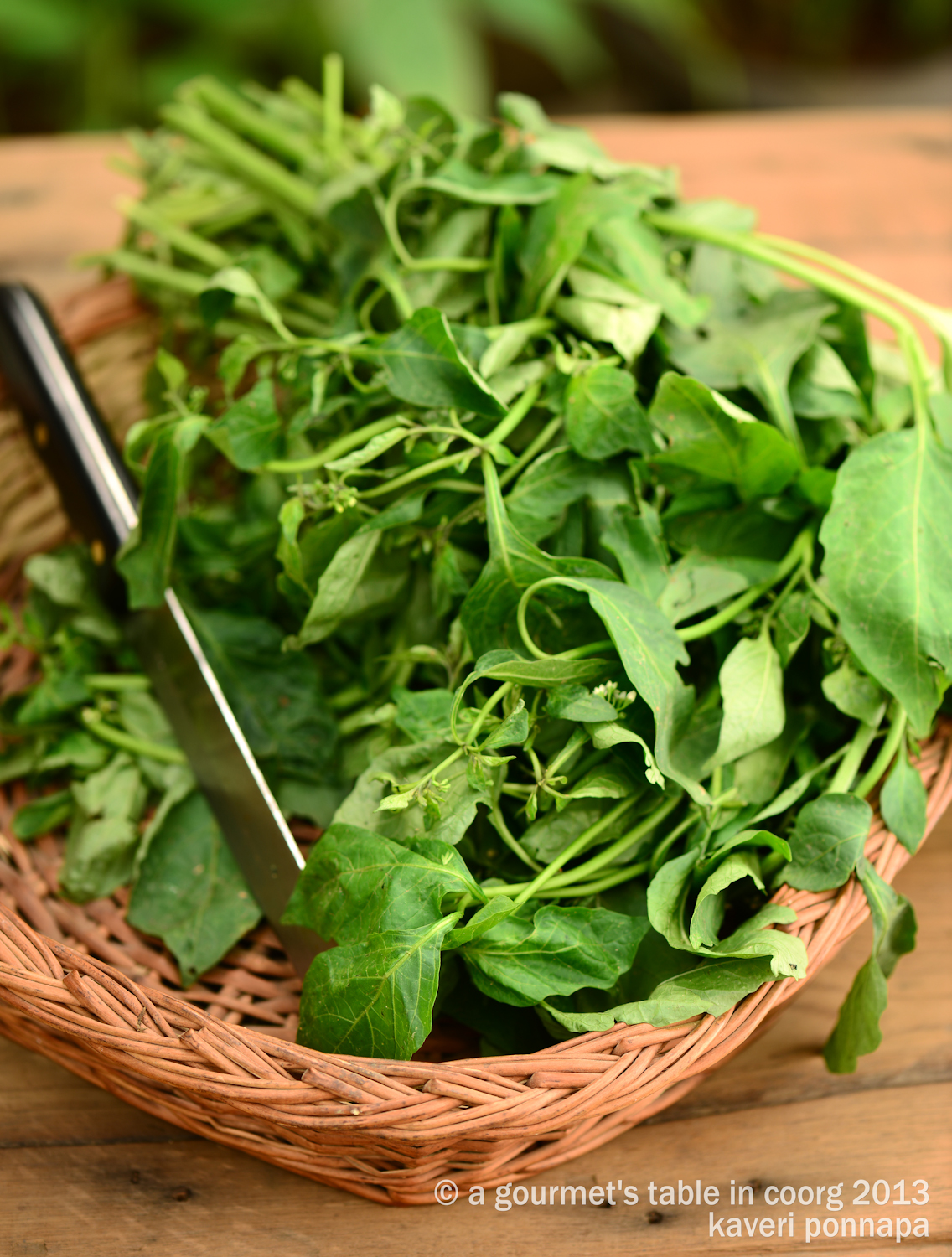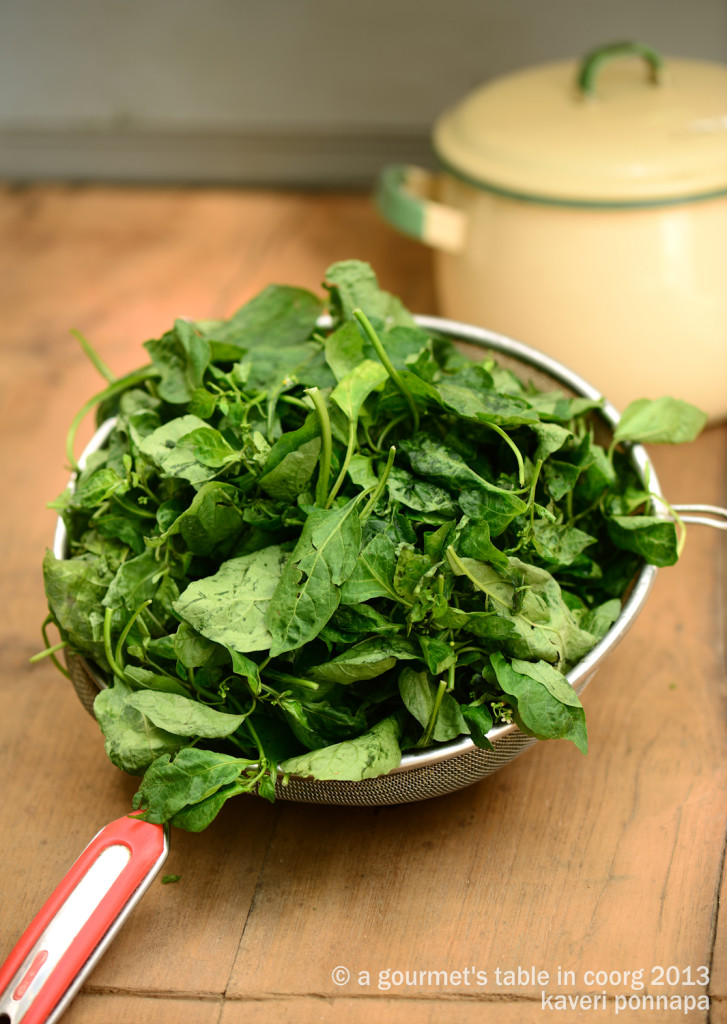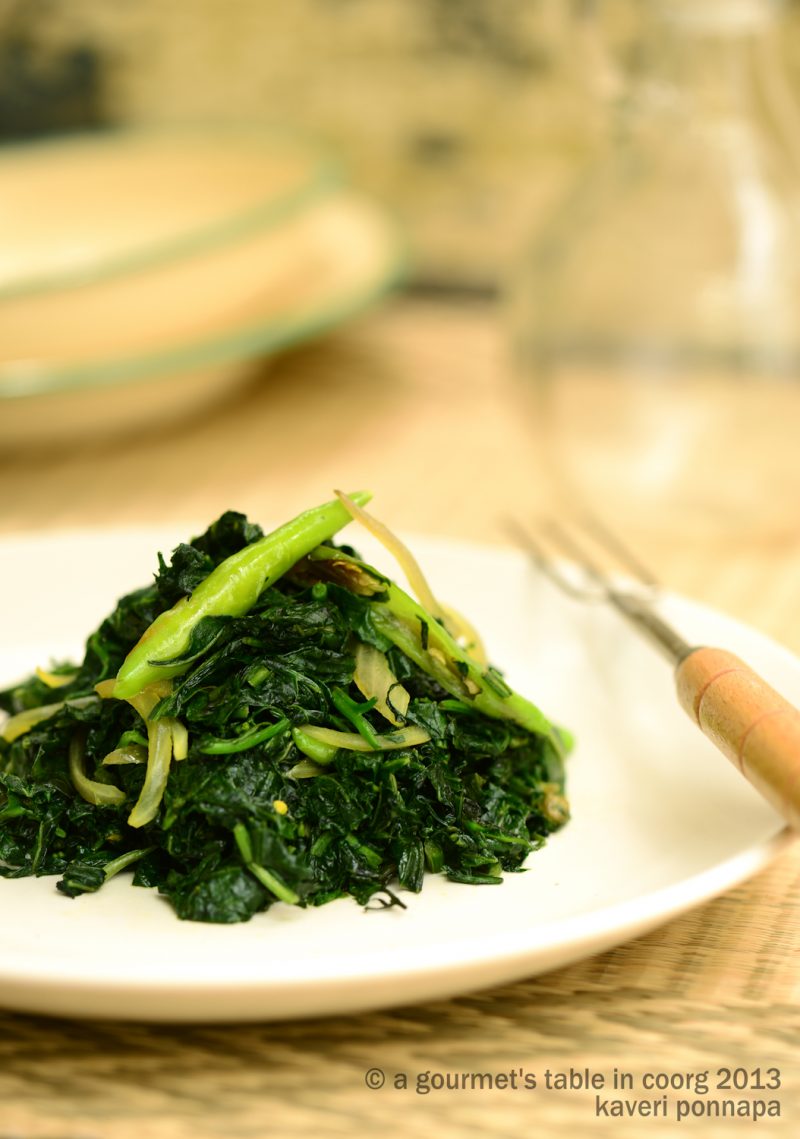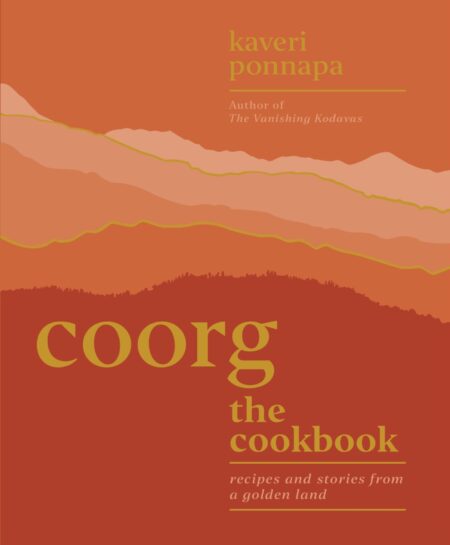Every now and then, the regular spread on the lunch table begins to look like too much of a good thing, particularly when I happen to be eating alone. My gaze sweeps over all the assembled dishes, the curries of mutton or vegetables, the bowls of pickles, and a vague dissatisfaction settles over my thoughts. At such times, my eyes search for, and invariably settle on a pile of stir-fried greens, kaké thoppe, that appears at least once a week on my table. A dark, glistening green in colour, it lies clumped in a disorderly manner on a shallow dish, like a tangle of seaweed washed ashore, with nothing even remotely attractive about it, except, perhaps, its colour. Stir-fried kaké thoppe, Solanum nigrum, is an acquired taste, and the local variety that grows in Coorg has an unmatched freshness and crispness.  Great big bunches lie in the kitchen, and once the somewhat tedious process of plucking, sorting and washing the leaves is done, you are just a few steps away from the finished dish. A heap of roughly chopped leaves, a thinly sliced onion, a spoonful of oil, slender, bright green chillies, slit along their length, a scattering of salt, and a very quick stir-fry. Then, a lid clamped down swiftly, to allow the pleasing bitterness of the leaves to meet the sweetness of onion, and come together under a steady steam. In a short while, you have a moist heap of elegantly bitter, tender leaves that can be combined with just about anything. Some days I eat it with a roti, for a frugal but inexplicably satisfying meal. On others, a small mound of steamed rice, a few spoonfuls of dal and the greens make a pleasing composition on my plate. Invariably, the mood turns quiet and contemplative, and memories of other, long-ago, meals, perfect in their simplicity, come floating to the surface. Either way, the palate-cleansing freshness of kaké thoppe wakes up the senses in a way a much more complex dish never can.
Great big bunches lie in the kitchen, and once the somewhat tedious process of plucking, sorting and washing the leaves is done, you are just a few steps away from the finished dish. A heap of roughly chopped leaves, a thinly sliced onion, a spoonful of oil, slender, bright green chillies, slit along their length, a scattering of salt, and a very quick stir-fry. Then, a lid clamped down swiftly, to allow the pleasing bitterness of the leaves to meet the sweetness of onion, and come together under a steady steam. In a short while, you have a moist heap of elegantly bitter, tender leaves that can be combined with just about anything. Some days I eat it with a roti, for a frugal but inexplicably satisfying meal. On others, a small mound of steamed rice, a few spoonfuls of dal and the greens make a pleasing composition on my plate. Invariably, the mood turns quiet and contemplative, and memories of other, long-ago, meals, perfect in their simplicity, come floating to the surface. Either way, the palate-cleansing freshness of kaké thoppe wakes up the senses in a way a much more complex dish never can. 
Kaké Thoppe Barthad
Stir-Fried Bitter Greens
- 2 generous bunches bitter greens (Kaké thoppe, Solanum nigrum)
- 1 oinion, thinly sliced
- 2-4 fresh green chillies, according to taste, slit lengthwise
- ¼ tsp mustard seeds, optional
- 3 tbsp oil
- salt to taste
Method:
- Sort the greens, using only the leaves and very tender stalks. Discard all hard or woody stalks.
- Wash thoroughly, and place in a colander to drain.
- Heat the oil in a wide pan or khadai, and when hot add the mustard seeds, if you are using them. Allow them to sputter.
- Add the sliced onion, and fry until wilted and soft, but not browned.
- Add the green chillies, and stir a few times.
- Finally, add the greens and salt, cover and cook in its own moisture until wilted and tender, approximately 5 – 7 mins. Do not overcook.
Cook’s Note: You may use a few pods of garlic, or dried red chillies to season this dish, but personally, I prefer the very simple recipe given above, as it allows the flavour of the greens to come through.
Substitutes for kaké thoppe in Bangalore: kasar gantu soppu or manthakali soppu.
Thank you for visiting this page. If you read something that you enjoy, or see an image that you like, please take a moment to write a response. Do look out for the recipes of all the food featured here in my upcoming cookbook.
Image Credits: Nithin Sagi
All Food Styling: Kaveri Ponnapa





Hi Radhika, must try recipe, thank you. We make one similar but it’s all cooked with a sprinkling of water,mashed and drizzled with coconut oil. Guess we malayali just have to add coconut oil 😊
Hi Mavi, this is a very simple, but very delicious way of frying the greens. If you can manage to get the ‘naati’ variety, the flavour really stands out. I’m told that a small helping of these leaves, everyday, is great for the health. About the coconut oil-I guess you can’t escape it in Kerala! ; )
Hi Kaveri! Such amazing recipes! All these are exactly like how mummy cooks..:) When is your book coming out!?Cheers!
Hello Poorna, thank you for the wonderful compliment, it can’t get better than this! I am so glad you like the pages-please do keep reading, and write in if you feel like. My cookbook is taking its own time, like books always do. I will post on these pages as soon as it is completed. I hope that it will have a lot to interest you. Warm wishes.Kaveri
Lovely recipe and beautiful pictures. I am going to try this recipe asap. Thank you for bringing so much abundance to the table 🙂
It’s so simple, but I am sure that you will love it Sangeeta. These are the traditional recipes of the Coorg countryside, and it’s so good to be able to share them on this page. Warm wishes.Kaveri
We Tamils use this cooked with moong dal, ginger and green chilly. Then season with mustard,hing,urad dal,red chilly and curry leaves.
Squeeze a little lime juice and eat with hot rice. It is delicious.
These greens have great stomach cleansing properties and heals ulcers and was always there on the menu at least once a month , as it is believed to kill worms too.
Hello Kausalya, thanks so much for sharing this, will certainly try it out before long, it does sound very good. Do test out some of the other vegetarian recipes too, Coorg vegetable dishes are as delicious as the ones that are all about meat.